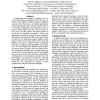Free Online Productivity Tools
i2Speak
i2Symbol
i2OCR
iTex2Img
iWeb2Print
iWeb2Shot
i2Type
iPdf2Split
iPdf2Merge
i2Bopomofo
i2Arabic
i2Style
i2Image
i2PDF
iLatex2Rtf
Sci2ools
ICAS
2008
IEEE
2008
IEEE
Model-Driven Engineering of Multi-target Plastic User Interfaces
A Multi-target user interface is composed of a series of interconnected variations of the same user interfaces, but tailored for different targets or different contexts of use. When access to software applications must be guaranteed in more than one context of use, it is necessary to adapt these user interfaces in order to preserve their usability when the switch between contexts occur. For this purpose, this paper proposes a model and a presentation technique to express and manipulate the plasticity domain of a user interface. The plasticity domain denotes the set of contexts of use it is able to cover while preserving its usability. In this paper, we focus on one aspect of the context of use: the platform screen size. A window requires a graphical area for its rendering and manipulation by the enduser. The model supports the definition of this graphical area in terms of window size and window place. The visualization technique helps in both making observable the set of presentations...
| Added | 30 May 2010 |
| Updated | 30 May 2010 |
| Type | Conference |
| Year | 2008 |
| Where | ICAS |
| Authors | Benoît Collignon, Jean Vanderdonckt, Gaëlle Calvary |
Comments (0)

